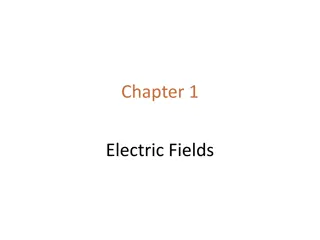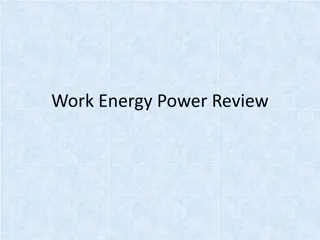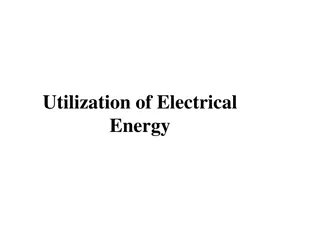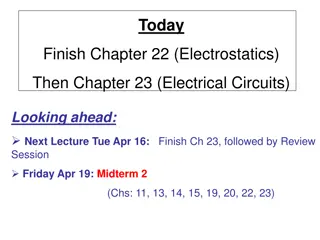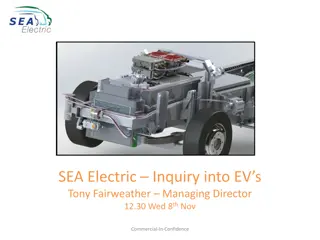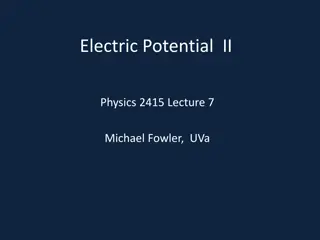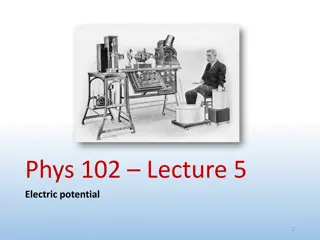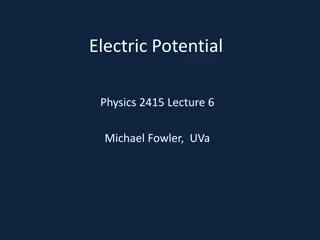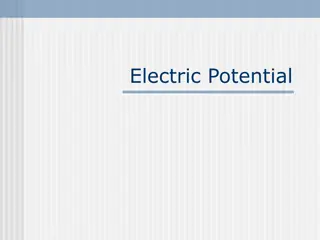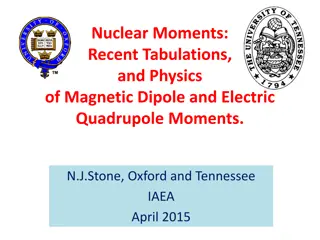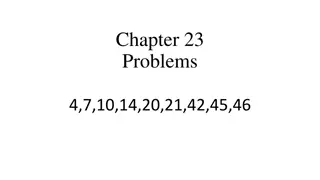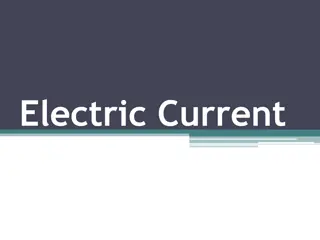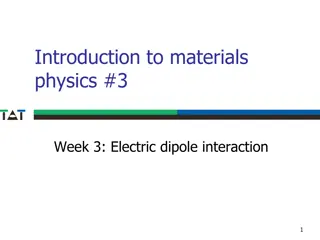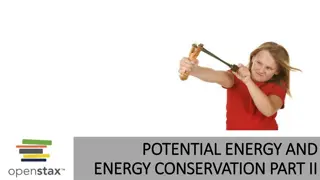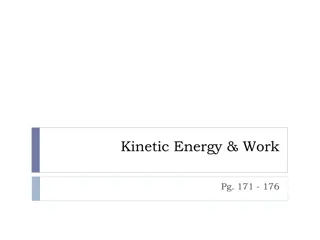Understanding Electric Potential and Work Energy Principle in Physics
Exploring electric potential and work energy principle in physics, this content discusses the conservative nature of electric force, potential energy of charges, electric potential energy calculations, and work done by external agents to move charges. Practical problems and theoretical concepts are intertwined to provide a comprehensive understanding.
Download Presentation

Please find below an Image/Link to download the presentation.
The content on the website is provided AS IS for your information and personal use only. It may not be sold, licensed, or shared on other websites without obtaining consent from the author. Download presentation by click this link. If you encounter any issues during the download, it is possible that the publisher has removed the file from their server.
E N D
Presentation Transcript
Chapter 24 Electric Potential
Books Problems Ch 24 Problems: 2, 4, 9, 15, 21, 35, 36, 41, 45, 46, 55, 62, 63, 64, 66, 84, 108.
Work Energy Principle You are taking charge at constant speed with force Fa from i to f. = W U = W U and a Work done by electric force Test charge = = = 0 . cos( 180 ) W r F rF rF F Fa +q Q+ Work done by external agent i r f Source charge = = = 0 F . cos( 0 ) W r rF rF a a a a = Wa W
Electric force F is conservative force like force of gravity, so the work depends on i and f . You are taking charge at constant speed with force Fa from i to f. . = dW r d F f . i = W r d F f kQ r F = U dr Fa 2 +q Q+ i f i d r r0 1 r 1 r = U kQq r 0 1 r 1 r = U kQq 0
Electric force F is conservative force like force of gravity, so the work depends on i and f . You are taking charge at constant speed with force Fa from i to f. f . i = W r d F f kQ i = + U dr 2 r F Fa 1 r 1 r +q = -Q U kQq f i d r r0 0 r 1 r 1 r = ( ) U k Q q 0 Potential energy depends on the sine of the charge
1 r 1 r = U kQq 0 1 r 1 r = U U kQq 0 0 When final point is at infinity, i.e. r = , tere will be no attraction or repulsion, so U = 0 1 1 r = 0 U kQq F 0 0 Fa Q+ +q f Qq i U = k r0 0 r 0 In General: Electric potential Energy U of a test charge q at a distance r from source charge Q , r Qq U = k r
r1 +Q +q1 P r2 -q2 r3 +q3 Electric Potential Energy of Charge Q ( ) Qq Qq Q q = + + 3 1 2 Uf k k k r r r 1 2 3 n Qq = i = i U k r 1 i Don t forget the sign of the charges!
a) Negative b) increase
T072: Q12. A charge q1 = -5.0 C and a charge q2 = 6.0C are located at (8.0 cm, 0.0) and (0.0 cm, 6.0 cm) respectively in the xy plane. How much work was done, by an external agent, to bring these charges to their final positions starting from infinite separation.[Consider V = 0 at infinity] (Ans: 2.7 J) T081: Q#14 Figure 6 shows three points X, Y and Z forming an equilateral triangle of side S in a uniform electric field of strength E. A unit positive test charge is moved from X to Y, then from Y to Z, and from Z back to X. Which one of the following correctly gives the work done by an external agent in moving the charge along the various parts of the path? (Ans: 0, -E*S*Sin(60 degrees) , + E*S*Sin(60 degrees).) S X Y Z E Figure 6 T081: Q#2: Three point charges are initially infinitely far apart. Two of the point charges are identical and have charge Q. If zero net work is required to assemble the three charges at the corners of an equilateral triangle of side d, then the value of the third charge is (Ans: - Q/2.)
T062:Q11.: Figure (3) shows three charges located at the corners of a triangle. How much energy would be needed to remove the 4 C charge to infinity? [Assume V = 0 at infinity.] (8.2J) T102-Q12. How much work is required to set up the arrangement of charges shown in Figure 6, if Q = 3 C? Assume that the charged particles are initially infinitely far apart and at rest. Take the potential to be zero at infinity. A) +0.06 J T101-Q15. In Figure 4, four charges are fixed at the corners of a square whose sides are of length 2d. The work done by an external agent to bring a fifth charge, Q, from infinity to the center of the square as shown in the figure is: (assume the potential at infinity to be zero) A) 1.4kqQ/d.
T102-Q12. How much work is required to set up the arrangement of charges shown in Figure 6, if Q = 3 C? Assume that the charged particles are initially infinitely far apart and at rest. Take the potential to be zero at infinity. A) +0.06 J
T92-Q17. Three electrons are initially infinitely far from each other. How much work (by an external agent) is required to place them on the corners of an equilateral triangle of side length 1.00 nm? A) + 6.91 10-19 J T83-Q11. Four equal positive charges, each 3.2 C, are held at the four corners of a square of edge 0.50m. How much work is required to move one of those charges far away from other three? A) 0.50 J T83-Q12. An electric field of 100 V/m strength is often observed near the surface of earth. What would be the electric potential at a point on the earth surface? (Radius of Earth= 6.37 x 106 m) A) 6.37 x 108V
T91-Q12. Two charges q = + 2.0 C are fixed a distance 2d = 2.0 cm apart (see Figure 5). With V = 0 at infinity, how much work needs to be done by an external agent to move one of the charges to point C? A) + 0.75 J T111-Q13. Three charged particles, q1 = +10 nC, q2 = 20 nC, and q3 = +30 nC, are positioned at the corners of a triangle, as shown in Figure 6. If a = 10 cm and b = 6.0 cm, how much work must be done by an external agent to move q3 to infinity? A) +2.7 10-5J 103-Q12. Calculate the electrostatic potential energy between a proton and an electron in a hydrogen atom of radius 52.9 pm (1 m = 1 1012 pm). Assume the electrostatic potential energy between the proton and electron is zero at infinite separation. Express your answer in electron-volts (eV). A) 27.2
103-Q12. Calculate the electrostatic potential energy between a proton and an electron in a hydrogen atom of radius 52.9 pm (1 m = 1 1012 pm). Assume the electrostatic potential energy between the proton and electron is zero at infinite separation. Express your answer in electron-volts (eV). A) 27.2
Electrical potential is defined as electric potential energy per unit charge U V = q Potential difference is potential energy difference per unit charge U = V q F +1 Unit of V = J/C = Volt (V) Q+ i f Potential difference between two points is defined as the work done to bring a unit positive charge from one point to another against the electric force f f U q F q . f = i = dr . V E = . dr U r d F i i
f = dr . V E i 1 r 1 r = V V kQ 0 0 When r = , V = 0 1 1 r = 0 V kQ F 0 0 Fa Q+ +1 f i Q r0 V = k 0 r 0 r Therefore, for point source charge Q Qq V = k U = k and 0 r r 0
+1 (unit positive charge) r1 +q1 P r2 Net potential at point P -q2 ( ) q q q = + + 3 1 2 V k k k r3 r r r 1 2 3 +q3 n q = i = i V k r 1 i Don t forget the sign of the charges!
T081: Q12. Point charges q and Q are placed as shown in Fig. 4. If q = +2.0 nC and Q = -2.0 nC, a = 3.0 m, and b = 4.0 m, what is the electric potential difference (VA-VB)? (Ans: 4.8 V) T03-Q13. Consider two points in an electric field. The potentials at point P1 is V1 = 0.24 kV, and at point P2 is V2 = + 0.36 kV. How much work is done by an external force in moving a charge q = 8.0 C from P2 to P1? A) 4.8 mJ T051: Q#12. What is the net potential at point P due to four point charges arranged in the configuration as shown in the Figure 1. Here q = 36 nC, d = 0.5 m. ) ( Ans: Vp = 324 V.) T081: Q10.: Points A (2.0 m, 3.0 m) and B (5.0 m, 7.0 m) are located in a region where the electric field is uniform and is given by E = 3i +4j (N/C). What is potential difference (VA-VB)? (Ans: 24 V)
T081: Q12. Point charges q and Q are placed as shown in Fig. 4. If q = +2.0 nC and Q = -2.0 nC, a = 3.0 m, and b = 4.0 m, what is the electric potential difference (VA-VB)? (Ans: 4.8 V)
T081: Q10.: Points A (2.0 m, 3.0 m) and B (5.0 m, 7.0 m) are located in a region where the electric field is uniform and is given by E = 3i +4j (N/C). What is potential difference (VA-VB)? (Ans: 24 V)
T101-Q10. A system consists of a negatively-charged particle moving in an electric field. When the charged particle moves in the direction of the electric field A) The electric potential energy increases. B) The work done by the electric force on the particle is positive. C) The electric potential energy decreases. D) The kinetic energy of the particle increases. E) The particle acceleration is in the direction of the electric field. T101-Q12. Three point charges 2.00 C, Q, and +6.00 C are fixed along the x-axis as shown in Figure 3. If the net electric potential at point P due to these charges is Zero, the charge Q is: A) 2.83 C
T102-Q13. Figure 7 shows two different arrangements of 12 electrons fixed in space. In the arrangement (a) they are uniformly spaced around a circle of radius R and in (b) they are non-uniformly spaced along an arc of the original circle. Which of the following statements is TRUE? A) The electric potential at the center C is the same in both (a) and (b). T91-Q10. In Figure 4, particles of charges q1 = + 5e and q2 = 15e are fixed in place with separation d. With V = 0 at infinity, at what point between the two particles and on the x axis is the net electric potential zero? [e = 1.6 10-19 C] A) x = d/4
T91-Q9. A uniform electric field is given by i E 12 (N/C). The coordinates (in meters) of two points in the xy plane are P1 = ( 2.0, + 1.0) and P2 = (+ 1.0, + 5.0). What is the potential difference V1 V2? A) + 36 V T111-Q15. Consider the four charges distributed as shown in Figure 8. What is the net electric potential at point P due to the four charges, if V = 0 at infinity, q = 10 nC, and d = 10 cm? A) +900 V
Outside the sphere (r > R): Charge concentrate at the centre like point charge S + + + + + q q E = Vp= k k P + + 2 r r R + At the surface (r = R): Charge concentrate at the centre like point charge + r + + + q E = 0 q E = k Vs= k 2 R i f R + + + But inside the surface (r < R), E = 0 + q + + + + To take charge from inside i to the surface f , there will be no work done + f = dr . V V E f i i V = V f i q = = V V k f i R The metallic body has same potential inside outside
+++ +++ + + + + ++ ++ + + + + + + + + + + E= 0 V 0 E=0 E=0 + + + + + + V 0 V 0 + + + + + + + + + + + + + + Potential inside the metallic sphere = Potential at the surface Surface with same potential = Equipotential Surface
+ + + + + + + + + + + + + + + + + + + + + + + + + + + + + + + q + + q2 + q1 + + + + + + V = V 1 2 q q 1= 2 k k R r The charge will flow form one sphere to another until both have the same potential. Battery cause to flow the charge because it has potential difference at its two terminals
T071: Q#18. A charged solid conducting sphere has a radius = 20 cm and a potential of 400V. Calculate the electric field 40 cm from the center of the sphere, (Ans: 500 V/m) T071:Q14. A conducting sphere with a radius of 10 cm, has a surface charge density of 4 10 6 C/m2. The electric potential, at r = 5 cm from the center of the sphere is ( assume V= 0 at infinity): (Ans: 4.5 104 V) T081: Q#11: Eight isolated identical spherical raindrops are each at a potential of 100 V at the surface, relative to the potential at infinity. They are combined together to make one spherical raindrop whose potential at the surface is: (Ans: 400 V)
T101-Q14. A solid conducting sphere of radius 5.0 cm has a charge 0.25 10 9 C distributed uniformly on its surface. If point A is located at the center of the sphere and point B is 15 cm from the center of the sphere, what is the magnitude of the electric potential difference between these two points? A) 30 V T92-Q15. An isolated conducting sphere has radius R = 0.20 m and a charge of +20 C. Point A is at a distance of 3R from the center of the sphere. If VC is the electric potential at the center of the sphere, what is the electric potential difference VC VA? A) +6.0 105 V T91-Q11. A conducting spherical shell has a radius of 0.800 m and carries a net charge of + 2.00 C. Point A is a distance rA = 0.500 m from the center of the shell, and point B is a distance rB = 1.50 m from the center of the shell. Take V = 0 at infinity. What is the electric potential difference VB VA? A) 10.5 kV
071-Q18. Consider two conducting spheres, A and B, having the same size. Sphere A carries a charge of 2.0 C and sphere B carries a charge of + 6.0 C. The spheres are touched together and then separated. What is the final charge on sphere A? (Ans: + 2.0 C.) Little difficult-Q18. Consider two conducting spheres, A and B. Sphere A carries 2.0 C has double radius than the sphere B that carries a charge of + 6.0 C. The spheres are touched together and then separated. What is the final charge on sphere A? (Ans: Bring your answer) T61-Q#13. A point charge of 5.0 10-9 C is transferred, by an external agent, from infinity to the surface of a ball of radius 5.0 cm. If the ball has the charge density 5.0 10-4 C/m2, then the amount of work done, by the external agent, in the process is: [Assume V = 0 at infinity.] (Ans: 1.4 10-2 J ) T062:Q10.: Two charged spherical conductors having radii 4.0 cm and 6.0 cm are connected by a long conducting wire. A total charge of 20 C is placed on this combination of two spheres. Find the charges on each sphere (smaller first). (8 C and 12 C)
T111-Q12. Consider two conducting spheres A and B. Sphere A has radius RA and carries charge q. Sphere B has radius RB = 3RA and initially uncharged. Sphere A is far from sphere B. The spheres are connected with a thin conducting wire. After the connection, what is the ratio of the charge on A to that on B (qA/qB )? A) 1/3 T102-Q18. A hallow spherical conductor of inner radius 2.0 cm and outer radius 4.0 cm has a net charge of 4.0 nC. If a point charge of 5.0 nC is placed at the center of the hallow spherical conductor, the charge density on the outer surface of the conductor is: A) + 50 nC/m2 T102-Q20. Eight identical spherical raindrops are each at a potential V (assuming the potential to be zero at infinity). They combine to make one spherical raindrop whose potential is: A) 4V
T102-Q18. A hallow spherical conductor of inner radius 2.0 cm and outer radius 4.0 cm has a net charge of 4.0 nC. If a point charge of 5.0 nC is placed at the center of the hallow spherical conductor, the charge density on the outer surface of the conductor is: A) + 50 nC/m2
T102-Q20. Eight identical spherical raindrops are each at a potential V (assuming the potential to be zero at infinity). They combine to make one spherical raindrop whose potential is: A) 4V
T91-Q11. A conducting spherical shell has a radius of 0.800 m and carries a net charge of + 2.00 C. Point A is a distance rA = 0.500 m from the center of the shell, and point B is a distance rB = 1.50 m from the center of the shell. Take V = 0 at infinity. What is the electric potential difference VB VA? A) 10.5 kV
If a surface has same potential everywhere it is called equipotential surface -q +q Electric Filed must be perpendicular to equipotential surfaces
Electric Filed must be perpendicular to equipotential surfaces + - +1C
- + +q +q +q i - + - + f - +q + i f -Q - + - + - + No work is done when charge moves in equipotential surface Work is done only if charge moves in different potentials Electric force is conservative force so work done by it only depends on the change in initial and final positions.
= E r . V f = dr . V E i = dV Edr dV = E dr V V V = = = Ey Ex Ez y x z
a) Rightward b) 1, 2, 3, 5 positive and 4 negative c) 3, than 1, 2 and 5 tie, then 4 T91-Q13. In a certain region of space the electric potential increases uniformly from east to west, and does not vary in any other direction. The electric field: A) points east and does not vary with position.
T072: Q10.: Over a certain region of space, the electric potential is give by: V(x,y) = x2+y2+2xy where V is in volts and x and y are in meters. Find the magnitude of the electric field at the point P (1.0 , 2.0). (Ans: 8.5 N/C) T052: Q#16. In a certain region of the xy plane, the electric potential is given by V (x,y) = 2xy 3x2 + 5y, where At which point is the electric field equal to zero? (Ans: 2.5, 7.5) T102-Q10. Figure 4 shows the x component of the electric field as a function of x in a region. The y and z components of the electric field are zero in this region. If the electric potential at x = 0 is 10 V, what is the electric potential at x = 3 m? A) +40 V T102-Q11. A particle of charge 2 10-3 C is placed in an xy plane where the electric potential depends on x and y as shown in Figure 5. The potential does not depend on z. What is the electric force (in N) on the particle? A)5i - 2 j
T102-Q10. Figure 4 shows the x component of the electric field as a function of x in a region. The y and z components of the electric field are zero in this region. If the electric potential at x = 0 is 10 V, what is the electric potential at x = 3 m? A) +40 V
T92-Q13. A charge of +28 nC is placed at the origin in a uniform electric field that is directed along the positive y-axis and has a magnitude of 4.0 104 V/m. The work done by the electric field when the charge moves to the point (3.0 m, 4.0 m) is: A) +4.5 mJ T92-Q14. An electron is placed in an xy plane where the electric potential depends on x and y as shown in Figure 4 (the potential does not depend on z). What is the electric field (in units of kV/m)? A) 5i 2j
T83-Q10. The electric potential at points in xy plane is given by V= 2x2y+32. What is the electric field at ( 2.0 m, 3.0 m) A) -24i - 8.0 j T111-Q14. The electric potential (in volts) in a certain region of space is given by V = 3xy. What is the magnitude of the electric field (in units of V/m) at the point (1.0 m, 1.0 m)? A) 4.2 T103-Q14. The electric potential in a certain region is given by V = 4 x z 5 y + 3 z2, where x, y, and z are in meters, and V is in volts. Find the magnitude of the electric field at the point (+2 m, 1 m, +3 m). A) 29 V/m T101-Q11. If the electric field has magnitude of 200 V/m and makes an angle of 30 with the positive x-axis, what is the potential difference VB-VA between point A(0, 0) and point B(3.0 m, 0 m)? A) 520 V
T103-Q14. The electric potential in a certain region is given by V = 4 x z 5 y + 3 z2, where x, y, and z are in meters, and V is in volts. Find the magnitude of the electric field at the point (+2 m, 1 m, +3 m). A) 29 V/m
T101-Q11. If the electric field has magnitude of 200 V/m and makes an angle of 30 with the positive x-axis, what is the potential difference VB-VA between point A(0, 0) and point B(3.0 m, 0 m)? A) 520 V
The repulsive force acting on the charge q is E = = F qE U qV + - + + + + + + - - - - - - + Work done by the electric field + + + + + - + + + - - - - - + + + + + - - - -q - - - - - = = = = . . W r F r qE q V U = + E W W + a f - + = + K U W W Vi a f d Vf Electron Volt (eV): 1 eV = 1.6 x 10-19 C. 1 V = 1.6 x 10-19 (C V) = 1.6 x 10-19 J 1eV = KE gained by an electron when accelerated trough a potential difference of 1V
T071:Q12. An electron is accelerated from a speed of 3106 m/s to 8106 m/s. Calculate the potential through which electron has to pass to gain this acceleration? (Ans: 157 V) Q#4. A proton with a speed of 3.0 105 m/s moves in uniform electric field of 1.9 103 N/C. The field is acting to decelerate the proton. How far does the proton travel before it is brought to rest? (Ans: 0.25 m ) T081: Q13.Two identical and isolated 8.0 C point charges are positioned on the x- axis, one is at x = +1.0 m and the other is at x = -1.0 m. They are released from rest simultaneously. What is the kinetic energy of either of the charges after it has moved 2.0 m along the x axis? (Ans: 96 mJ) T052: Q#13. Two electrons are initially far away. Each electron is moving toward the other one with a speed of 500 m/s. Find the closest distance they can get to each other. (Ans: 1.01 mm) T61-Q#12. An electron starts from rest at a point 10 cm from a positively charged conducting plate, with a surface charge density = +1 10-9 C/m2. The electron is attracted to the plate until it collides with the plate. With what speed will the electron collide with plate? (Ans: 2.0 106 m/s


